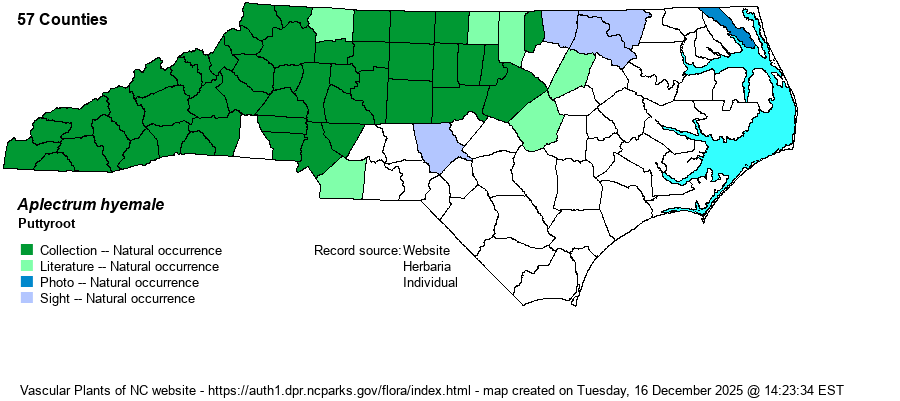| Author | (Muhlenberg ex Willdenow) Torrey | |
| Distribution | Occurs throughout the Mountains, and essentially throughout the Piedmont (probably in all counties, though possibly absent in the southeastern corner of the province), to the Fall Line. Other than a photo record for Camden County, there appear to be no other records for the Coastal Plain.
This is a somewhat Northern species ranging from southern Canada south to central NC, northern GA, and eastern OK. | |
| Abundance | Fairly common to frequent in the Mountains and western Piedmont. Infrequent in most of the rest of the Piedmont, and quite uncommon in the far northeastern Piedmont counties. | |
| Habitat | This is a species of rich, moist hardwood forests, often growing in habitats where American Beech (Fagus grandifolia) is present. Mesic Mixed Hardwood Forests are favored, but it does grow in drier portions of bottomland forests. It may grow in Rich Cove Forests and Basic Mesic Forests, but it is mainly found in soils just slightly acidic to circumneutral and not truly basic. |
| Phenology | Blooms in May and June, and fruits shortly afterwards. However, the single basal leaf remains green through the winter, before decaying in spring just before blooming.
| |
| Identification | This is a unique species in North America, having a single naked flowering stem (scape) that emerges in spring. This scape is pale green, growing to about 1 foot tall, with about 15 moderately large (almost 1 inch across from petal tip to petal tip) pale yellow-green to purplish flowers. However, the flowers have petals that mostly spread forward, and flowers quickly droop downward after blooming. Also, because there is no basal leaf visible at the time of flowering, and the tree canopy is closed at that time of year (usually in May), you can easily walk past a flowering stem without noticing it! Thankfully, it is much easier to spot later in summer thru mid-winter, when the quite large single elliptical leaf is present. It is quite wrinkled in appearance, with entire margins, growing to about 5 inches long. Most importantly, it is conspicuously striped in narrow/thin longitudinal bands of white and green; such a leaf is hard to overlook in winter, when no other large white-and-green striped leaves lie flat on the ground. From mid-summer into winter, your eye might also catch the drooping buffy-colored seed pods on the scape. The most similar species -- Cranefly Orchid (Tipularia discolor) -- has much narrower petals, blooms in mid- to late summer, and has a smaller basal leaf that is green above but strongly purple below. | |
| Taxonomic Comments | None
| |
| Other Common Name(s) | Adam-and-Eve is fairly often used, but not nearly as much as is Puttyroot. | |
| State Rank | S4 | |
| Global Rank | G5 | |
| State Status | | |
| US Status | | |
| USACE-agcp | FAC link |
| USACE-emp | FAC link |

